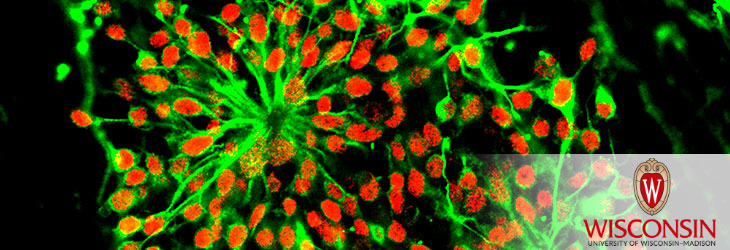Pluripotent Stem Cells

Methods For Cardiac Fibroblast Differentiation of Human Pluripotent Stem Cells
WARF: P160319US02
Inventors: Timothy Kamp, Jianhua Zhang
The Wisconsin Alumni Research Foundation (WARF) is seeking commercial partners interested in methods for cardiac fibroblast differentiation of human pluripotent stem cells.
Overview
Cardiac fibroblasts (CF) comprise a major fraction of the total cells in the heart and can arise from mesodermal progenitor cells as the heart develops. CFs are primarily responsible for generating extracellular matrix and secreting cytokines and growth factors to stimulate myocytes growth and division as well as dynamically remodel the extracellular matrix in response to various stresses that the heart adapts. CFs play a central role in many forms of heart disease, such as cardiac hypertrophy and arrhythmias and heart failure. Therefore, CFs have been used for models testing drug toxicity and therapeutic efficacy as well as tissue engineering for cardiac repair. However, access to primary human CF is limited by the scarcity of viable cardiac tissue. In addition, primary CFs can only passage only a limited number of time before senescence. Thus a robust and reliable source of human CFs is needed for cardiovascular research and therapeutic application.
The Invention
UW-Madison researchers have developed efficient and cost-effective protocols for generating functional cardiac fibroblast from human pluripotent stem cells (hPSC) under chemically defined culture conditions and for long-term maintenance of such hPSC-derived cardiac fibroblast cell populations. These CFs have been demonstrated to express cardiac-specific genes highlighted by the expression of the transcription factors GATA4 and Tbx20. By co-culturing CFs with cardiomyocytes, the researchers have generated a human arrhythmia model. The researchers have also provided a method of screening a test agent including nucleic acid, peptide, a ploypeptide and antibody on CFs using electrical impulse propagation pattern as a defined functional parameter.
Applications
- In vitro models testing drug toxicity as well as therapeutic efficacy measuring the release of known cytokines linked to hypertrophy and other heart disease in response to small molecules
- Precision medicine applications to understand patient specific responses to medications or other applications such as disease modeling
- Delivered alone or in combination with CMs in engineered cardiac tissue potentially contribute to significant repair of the injured adult heart following myocardial infarction or other insults
- Producing needed matrix and remodeling of grafts during growth, which pave the ways towards treating congenital heart diseases
Key Benefits
- More efficient than other methods
- Identity and functional properties of CFs differentiated from hPSCs thoroughly characterized
- CFs differentiated from hPSCs allow 10-13 passages before senesce compared to primary CFs.
- High scientific implication-in vitro testing models for drug toxicity and therapeutic efficacy
- Potential high health implication-application from precision medicine application to regenerative medicine.
Stage of Development
The researchers have optimized and defined their protocol, and characterized the resulting cells.
Additional Information
For More Information About the Inventors
Tech Fields
For current licensing status, please contact Andy DeTienne at [javascript protected email address] or 608-960-9857